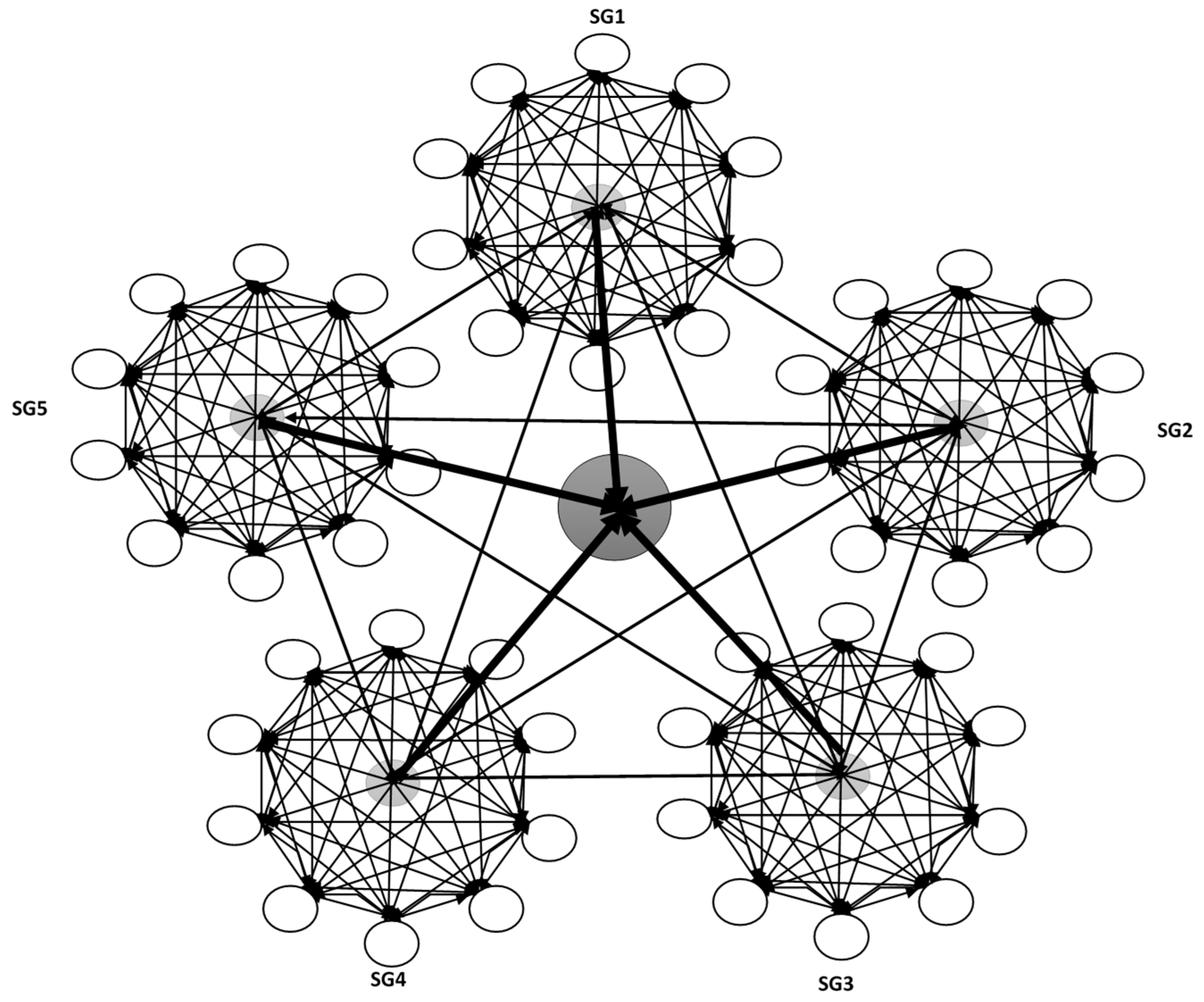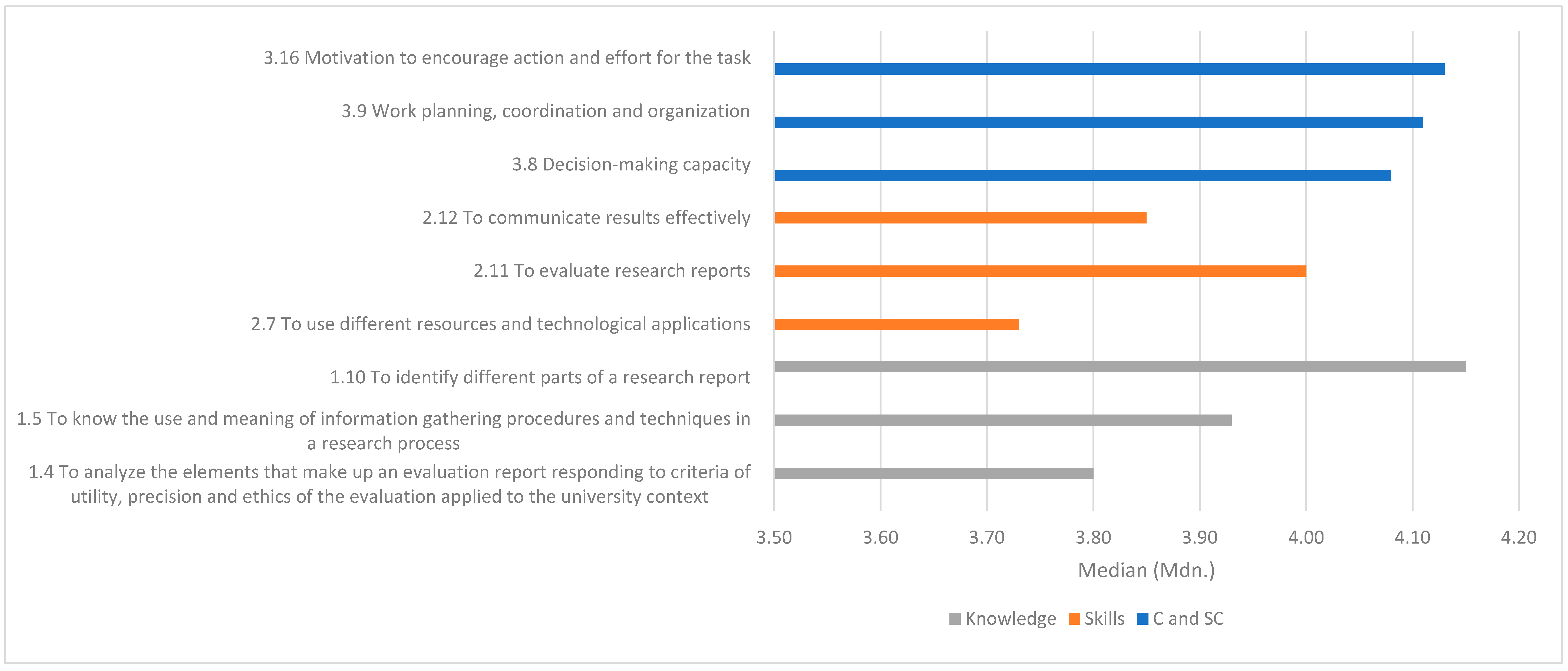Teaching Using Collaborative Research Projects: Experiences with Adult Learners in Distance Education
Abstract
:1. Introduction
2. Literature Review
“The courses leading to the official degree of Electromechanical Engineer must provide adequate training in the theoretical bases and technologies of this Engineering”.
2.1. Aims, Objectives, and Learning Outcomes
2.2. Competences
2.3. Research Hypotheses
3. Methodology
3.1. Participants
3.2. Research Design and Procedures
3.3. Measures
3.4. Data Analysis
4. Results
4.1. Knowledge or Cognitive Competences
4.2. Skills or Functional Competences
- To elaborate proposals to develop techniques to obtain information (79%);
- To design a group-training plan and develop the training actions involved (80%);
- To evaluate the research report that they deliver once the course has been completed (93%);
- To transmit the results effectively according to the conclusions that each working group draws from the work process carried out through collaborative research conducted online (85%).
4.3. Competencies and Social Competence
- Rigour and accuracy application in the use of measurement instruments for the study of educational and research reality (73%);
- Diagnostic and research capacity to elaborate material and provide the research with a theoretical context (77%);
- Development of a critical, positive, and plural attitude towards research as a tool for understanding and improving the education reality in different contexts (81%);
- Coordination, organization, and supervision capacity in the different tasks of the whole research process (75%);
- Development of creativity in the design and use of resources, both the existing ones and those elaborated by each working group (91%).
5. Discussion
6. Conclusions
Author Contributions
Funding
Institutional Review Board Statement
Informed Consent Statement
Data Availability Statement
Conflicts of Interest
References
- González, J.; Wagenaar, R. Tuning Educational Structures in Europe; Final Report, Phase One; Deusto University: Bilbao, Spain, 2003; Available online: http://tuningacademy.org/wp-content/uploads/2014/02/TuningEUI_Final-Report_EN.pdf (accessed on 3 September 2021).
- Wang, J.; Hicks, D. Scientific teams: Self-assembly, fluidness, and interdependence. J. Informetr. 2015, 9, 197–207. [Google Scholar] [CrossRef]
- Wagner, C.S.; Whetsell, T.A.; Leydesdorff, L. Growth of international collaboration in science: Revisiting six specialties. Scientometrics 2017, 110, 1633–1652. [Google Scholar] [CrossRef]
- Tikunoff, W.J.; Ward, B.A. Collaborative research on teaching. Elem. Sch. J. 1983, 83, 453–468. [Google Scholar] [CrossRef]
- Stein, M.J.; Daugherty, A.; Rivera, I.; Muzzo, J.; Lynn, C.D. Thinking outside anthropology’s box: Socializing undergraduates through collaborative research, teaching, and service. Ann. Anthropol. Pract. 2016, 40, 164–177. [Google Scholar] [CrossRef]
- Snodgrass, J.G. Online virtual worlds as anthropological field sites: Ethnographic methods training via collaborative research of Internet gaming cultures. Ann. Anthropol. Pract. 2016, 40, 134–147. [Google Scholar] [CrossRef]
- Li, Z. Collaborative research approaches between universities and schools: The case of New Basic Education (NBE) in China. Educ. Stud. 2020, 46, 385–403. [Google Scholar] [CrossRef]
- Barnes, T.; Pashby, I.; Gibbons, A. Effective university–industry interaction: A multi-case evaluation of collaborative RandD projects. Eur. Manag. J. 2002, 20, 272–285. [Google Scholar] [CrossRef]
- Keraminiyage, K.P.; Haigh, R.P.; Amaratunga, R.D.G. Achieving success in collaborative research: The role of virtual research environments. J. Inf. Technol. Constr. (ITcon) 2009, 14, 59–69. [Google Scholar]
- Chen, C.H.; Yang, Y.C. Revisiting the effects of project-based learning on students’ academic achievement: A meta-analysis investigating moderators. Educ. Res. Rev. 2009, 26, 71–81. [Google Scholar] [CrossRef]
- WHO; PAHO. Core Competencies for Public Health: A Regional Framework for the Americas; World Health Organization: Washington, DC, USA, 2013. [Google Scholar]
- ANECA. Títulos de Grado en el Ámbito de la Ingeniería Industrial. February 2006. Available online: https://www.uv.es/eees/archivo/libro%20blanco%20propuesta%20Escuelas%20Superiores.pdf (accessed on 5 May 2021).
- University Degree in Electromechanical Engineering Royal Decree 921/1992 (Spain). Real Decreto 921/1992, de 17 de Julio, por el que se Establece el título Universitario oficial de Ingeniero Industrial y la Aprobación de las Directrices Generales Propias de los Planes de Estudios Conducentes a la Obtención de Aquél. Available online: https://www.boe.es/buscar/doc.php?id=BOE-A-1992-20368 (accessed on 5 May 2021).
- Whitehead, M. How aims and objectives influence teaching. In A Practical Guide to Teaching Physical Education in the Secondary School; Routledge: London, UK, 2013; pp. 29–33. [Google Scholar]
- Kennedy, D.; Hyland, A.; Ryan, N. Writing Learning Outcomes—A Practical Guide; University College Cork: Cork, Ireland, 2007. [Google Scholar]
- Bologna Working Group. A Framework for Qualifications of the European Higher Education Area; Bologna Working Group Report on Qualifications Frameworks; Danish Ministry of Science, Technology and Innovation: Copenhagen, Denmark, 2005. [Google Scholar]
- Moon, J. The Module and Programme Development Handbook; Kogan Page Limited: London, UK, 2002. [Google Scholar]
- Hartel, R.W.; Foegeding, E.A. Learning: Objectives, Competencies, or Outcomes? J. Food Sci. Educ. 2004, 3, 69–70. [Google Scholar] [CrossRef]
- Royal Decree 1393/2007, of October 29, Which Establishes the Planning of Official University Education. Original Language Title: Real Decreto 1393/2007, de 29 de Octubre, por el que se Establece la Ordenación de las Enseñanzas Universitarias Oficiales. Available online: https://www.boe.es/buscar/pdf/2007/BOE-A-2007-18770-consolidado.pdf (accessed on 5 May 2021).
- Chomsky, N. Aspects of the Theory of Syntax; MIT Press: Cambridge, MA, USA, 1965. [Google Scholar]
- Cronen, V.E. Practical Theory and the Tasks Ahead for Social Approaches to Communication. In Social Approaches to Communication; Leeds-Hurwitz, W., Ed.; Guilford: New York, NY, USA, 1995; pp. 217–242. [Google Scholar]
- Anderson, L.W.; Krathwohl, D.R. A Taxonomy for Learning, Teaching, and Assessing: A Revision of Bloom’s Taxonomy of Educational Objectives; Longman: London, UK, 2001. [Google Scholar]
- Darwazeh, A.N. A new revision of the [revised] bloom’s taxonomy. Distance Learn. 2017, 14, 13–28. [Google Scholar]
- Ploum, L.; Blok, V.; Lans, T.; Omta, O. Toward a validated competence framework for sustainable entrepreneurship. Organ. Environ. 2018, 31, 113–132. [Google Scholar] [CrossRef] [PubMed]
- European Commission. The European Qualifications Framework for Lifelong Learning (EQF); Office for Official Publications of the European Communities: Luxembourg, 2008; Available online: http://ec.europa.eu/education/pub/pdf/general/eqf/broch_en.pdf (accessed on 5 November 2011).
- Winterton, J.; Delamare-Le Deist, F.; Stringfellow, E. Typology of Knowledge, Skills and Competences: Clarification of the Concept and Prototype; Office for Official Publications of the European Communities: Luxembourg, 2006. [Google Scholar]
- Mead, L.H. Faculty Perspectives of Student-Faculty Collaborative Course Design; Teaching and Learning in Communication Sciences & Disorders; ISU ReD: Research and eData; USA, 2018; Volume 2, Available online: https://ir.library.illinoisstate.edu/cgi/viewcontent.cgi?article=1039&context=tlcsd (accessed on 5 May 2021).
- Dyck, M.J.; Novotny, N.L.; Blakeman, J.; Bricker, C.; Farrow, A.; LoVerde, J.; Nielsen, S.D.; Johnson, B. Collaborative student-faculty research to support PhD research education. J. Prof. Nurs. 2020, 36, 106–110. [Google Scholar] [CrossRef] [PubMed]
- Dobber, M.; Akkerman, S.F.; Verloop, N.; Vermunt, J.D. Student teachers’ collaborative research: Small-scale research projects during teacher education. Teach. Teach. Educ. 2012, 28, 609–617. [Google Scholar] [CrossRef]
- Whelan, K.; Thomas, J.E.; Madden, A.M. Student Research Projects: The Experiences of Student Dietitians, University Faculty Members, and Collaborators. J. Am. Diet. Assoc. 2007, 107, 1567–1574. [Google Scholar] [CrossRef] [PubMed]


| Tasks | Month | |||||||||||||||
|---|---|---|---|---|---|---|---|---|---|---|---|---|---|---|---|---|
| January | February | March | April | |||||||||||||
| W1 | W2 | W3 | W4 | W1 | W2 | W3 | W4 | W1 | W2 | W3 | W4 | W1 | W2 | W3 | W4 | |
| Formulation and approach of problems that aroused the curiosity and interest of university students | X | X | X | |||||||||||||
| Cooperative planning of research tasks | X | X | ||||||||||||||
| Obtaining relevant information from documentaries, computer sources, and so on. | X | X | X | |||||||||||||
| Classification, arrangement, and interpretation of relevant information from documentary sources | X | X | X | |||||||||||||
| Drafting of a final report | X | X | X | X | ||||||||||||
| Sharing and discussion of the research work in the class | X | X | ||||||||||||||
| Conducting surveys of university students | X | X | ||||||||||||||
| 1. Knowledge or cognitive competences (K) |
| 1.1 To know the basic theoretical foundations of electromechanical engineering |
| 1.2 To understand the new trends in electromechanical engineering |
| 1.3 To identify the main components of the evaluation model of university education based on collaborative projects |
| 1.4 To analyse the elements which make up an evaluation report responding to criteria of utility, precision and ethics of the evaluation applied to a university context |
| 1.5 To know the use and meaning of information gathering procedures and techniques in a research process |
| 1.6 To know the main models of group training, development, and completion |
| 1.7 To understand and apply appropriate methodological strategies and techniques for the resolution of research cases |
| 1.8 To know results of applied research on more effective intervention techniques, programmes, or strategies with each type of individual |
| 1.9 To identify the characteristics that define and profile individuals and groups in different educational contexts |
| 1.10 To identify different parts of a research report |
| 1.11 To know the theoretical foundations and design of resources, materials, and training programs |
| 2. Skills or functional competences (S) |
| 2.1 To contrast different theories of research methodologies applied to engineering |
| 2.2 To identify the educational actions developed by the agents involved in a training process |
| 2.3 To apply educational measurement instruments adapted to the research objectives |
| 2.4 To design a teaching-learning process |
| 2.5 To know how to apply research projects that promote professional development and projection towards research and teaching careers |
| 2.6 To develop intellectual and scientific competences related to the generation of scientific knowledge |
| 2.7 To use different resources and technological applications |
| 2.8 To develop proposals and to develop information-gathering techniques |
| 2.9 To design a group-training plan and to develop the training actions involved |
| 2.10 To plan the improvement aspects of the project according to quality criteria |
| 2.11 To evaluate research reports |
| 2.12 To communicate results effectively |
| 3. Competencies and social competence (C and SC) |
| 3.1 Analysis and synthesis capacity |
| 3.2 Reflective capacity |
| 3.3 Systematic and global vision |
| 3.4 Critical and analytical capacity in educational and research situations which can be evaluated |
| 3.5 To encourage an open, flexible, and understanding attitude on the complex nature of the evaluation process |
| 3.6 Rigour and accuracy application in the use of measurement instruments for the research and educational reality study |
| 3.7 Diagnostic and research capacity |
| 3.8 Decision-making capacity |
| 3.9 Work planning, coordination, and organization |
| 3.10 Development of a critical, positive, and plural attitude towards research as a tool for understanding and improving the educational reality |
| 3.11 Rigour in the analysis and assessment of resources and contexts |
| 3.12 Coordination, organization, and supervision capacity |
| 3.13 Approach to searching for diverse documentary and bibliographic sources |
| 3.14 Development of creativity in the design and use of resources |
| 3.15 Assessment of distance/guided training |
| 3.16 Motivation to encourage action and effort for the task |
Publisher’s Note: MDPI stays neutral with regard to jurisdictional claims in published maps and institutional affiliations. |
© 2021 by the authors. Licensee MDPI, Basel, Switzerland. This article is an open access article distributed under the terms and conditions of the Creative Commons Attribution (CC BY) license (https://creativecommons.org/licenses/by/4.0/).
Share and Cite
Rosales-Asensio, E.; Sierra, C.; Pérez-Molina, C.; Romero-Mayoral, J.; Colmenar-Santos, A. Teaching Using Collaborative Research Projects: Experiences with Adult Learners in Distance Education. Sustainability 2021, 13, 10437. https://doi.org/10.3390/su131810437
Rosales-Asensio E, Sierra C, Pérez-Molina C, Romero-Mayoral J, Colmenar-Santos A. Teaching Using Collaborative Research Projects: Experiences with Adult Learners in Distance Education. Sustainability. 2021; 13(18):10437. https://doi.org/10.3390/su131810437
Chicago/Turabian StyleRosales-Asensio, Enrique, Carlos Sierra, Clara Pérez-Molina, Jesús Romero-Mayoral, and Antonio Colmenar-Santos. 2021. "Teaching Using Collaborative Research Projects: Experiences with Adult Learners in Distance Education" Sustainability 13, no. 18: 10437. https://doi.org/10.3390/su131810437
APA StyleRosales-Asensio, E., Sierra, C., Pérez-Molina, C., Romero-Mayoral, J., & Colmenar-Santos, A. (2021). Teaching Using Collaborative Research Projects: Experiences with Adult Learners in Distance Education. Sustainability, 13(18), 10437. https://doi.org/10.3390/su131810437









